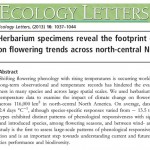We frequently talk about the nature of our collections, the techniques that we use to preserve specimens, and sometimes about the living organisms that they represent. This time I would like to comment on what we can DO with the specimens. We are preserving them for the information that they contain, so let’s look at an example of how we can use that information.
A key point about museum collections is that, if done correctly, they preserve the organism with data about where and when it was collected. That spatial and temporal information is valuable and is why individual specimens are truly irreplaceable – you cannot go back in time to recollect something.
Climate change is a big topic in the news these days and because it is about change – something different in one time from another – museum specimens can be relevant to studying it. If in fact the climate is warming in a particular area, one expectation is that the growing season may lengthen – it might start a little earlier in spring and end a little later in autumn. If we could compare when plants begin flowering in spring, for example, we might find that for various species they flower somewhat earlier on average in the climate has warmed.
 A study performed by one of the graduate students in our department was designed to investigate this. Kellen Calinger used herbarium specimens from our collection from across Ohio. She targeted plants at the peak of bloom, which meant that she needed to be careful that she was comparing plants in the same state of flowering (not just opening and not getting past), which she was easily able to do by examining each sheet. She restricted her sampling to a fairly narrow area to prevent the confounding effects of north-south variation in seasons. She analyzed 141 species collected over 115 years, including those flowering in spring, early and late summer. She also considered whether the species were herbaceous or woody, annual or perennial, wind or insect pollinated, and whether they were native or introduced.
A study performed by one of the graduate students in our department was designed to investigate this. Kellen Calinger used herbarium specimens from our collection from across Ohio. She targeted plants at the peak of bloom, which meant that she needed to be careful that she was comparing plants in the same state of flowering (not just opening and not getting past), which she was easily able to do by examining each sheet. She restricted her sampling to a fairly narrow area to prevent the confounding effects of north-south variation in seasons. She analyzed 141 species collected over 115 years, including those flowering in spring, early and late summer. She also considered whether the species were herbaceous or woody, annual or perennial, wind or insect pollinated, and whether they were native or introduced.

A graph from the Calinger et al. paper showing the gradual upward trend in temperatures over the past century.
What did she find? First, she found that there was considerable variation among the species with respect to how they responded to warming temperature. Sixty-six species (46%) showed significant advancement of flowering time with increasing temperature, while only two species (1%) showed a delay in flowering time. The remainder did not show a statistically significant change. Overall, flowering advanced 3.4 days per every degree (F) of warming for those 46% of species that were most sensitive, it was 5.2 days per degree. Spring flowering species were more responsive than those that flower in early or mid-summer, suggesting that there is a “buffering effect” as you move into the growing season. Wind-pollinated species (such as oaks) were more strongly affected than insect pollinated species, and introduced species were markedly more affected than native species. Annuals were more affected than perennials.
How much of an effect is this? For Phacelia purshii (common name: Miami Mist) in northeastern Ohio, where the temperature effect seems strongest, it is flowering now two weeks earlier than it did a century ago. Many species in the study showed this pattern. One of the most troubling findings was the fact that introduced species seem to be very responsive to warming, suggesting that invasives may become an increasing problem.
Enough of the bad news – my point here was to emphasize what we can learn from museum collections that we could not otherwise know. Without the documentation of the presence of species at particular places and times, we would have no way to perform this kind of analysis. It’s just one example of what we can learn from our collections.
About the Author: Dr. John Freudenstein is a Professor in the Department of Evolution, Ecology and Organismal Biology and Director of the OSU Herbarium.
